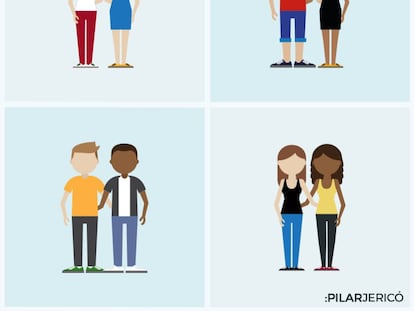The science of having your heart in the right place
Spanish researchers explain the signals that push the organ to the left during embryogenesis
A team of researchers from the Alicante Institute for Neuroscience (IN) has published an article in Nature magazine explaining how our hearts move to the left during the early stages of embryonic development.

At the start of an embryo’s development, cells move around in much the same way that cancer cells move later in life. From the moment the sperm fertilizes the egg, their DNA codes work to produce proteins. These in turn reproduce the cells that gather in what appears to be a formless mass. Gradually, however, a series of biochemical signals move the cells around until they begin to resemble a human being.
When this process is completed, the cells lose their capacity to move and focus instead on growth and development.
The heart’s position, with the lower end pointing left, is key to connecting with veins and arteries
When embryogenesis begins, our organs are arranged in the center of the body and, among certain invertebrates, that is where they will stay. But in vertebrates such as humans, a more complex system of distribution is carried out, moving the liver to the right, for example, and the heart to the left.
In the case of the heart, once it has started to form it attracts cells from both the left and right, yet it shifts left. According to Ángela Nieto, head of the IN research team, the accepted explanation for this asymmetrical result is that the series of signals causing the movement were repressed on the right side. Nieto’s team, however, detected an additional mechanism at play. “There was greater gene expression on the right side” – triggering a larger flow of cells from the right, pushing the heart left.
Nieto and her team began by studying the process in chicken embryos. Later, they confirmed their findings in zebrafish and mice, allowing them to conclude that the mechanism worked in various species and probably in humans. “The zebrafish is transparent, so cell movement is easier to study,” says Oscar Ocaña, who began the research 25 years ago. “We demonstrated that if you arrest the function of those genes and thus the flow of cells towards the heart, the heart remains in the center in all three species.”
“The location of our organs is connected to efficient collaboration with other systems, such as the vascular system,” says Nieto.
The heart’s position, with the lower end pointing left, is key to its connection with veins and arteries. In evolutionary terms, natural selection has favored mutations that lead to more efficient organs. That said, a human’s heart is very different to an invertebrate’s.
Unfortunately, the infinite number of biochemical signals that position the organs don’t always work perfectly. In many cases, they are destroyed by the embryo’s own security system when it detects what it thinks are errors. In some cases, development continues despite this. At birth, not only are 50% of defects heart-related, but many are linked to the heart’s location.
Ángela Nieto and her team could help our understanding of illnesses such as cancer
Nieto and her team’s bid to better understand the signal system that governs embryonic development could help our understanding of illnesses such as cancer. “We pinpoint the proteins that give the cells their capacity to move around,” says Nieto. “We have been able to study this at various stages in the embryo’s development and have observed how ‘the program’ comes to an end when the process is finished, but we know that it can start up again further down the line in a pathological manner.”
Cancer cells have recovered this capacity to move and are able to spread from the main tumor to other organs.
The Spanish team is now working on understanding the location of other organs, such as the liver, with the final goal of working out the cellular choreography that creates human beings and, at times, destroys them.
English version by Heather Galloway.
Tu suscripción se está usando en otro dispositivo
¿Quieres añadir otro usuario a tu suscripción?
Si continúas leyendo en este dispositivo, no se podrá leer en el otro.
FlechaTu suscripción se está usando en otro dispositivo y solo puedes acceder a EL PAÍS desde un dispositivo a la vez.
Si quieres compartir tu cuenta, cambia tu suscripción a la modalidad Premium, así podrás añadir otro usuario. Cada uno accederá con su propia cuenta de email, lo que os permitirá personalizar vuestra experiencia en EL PAÍS.
¿Tienes una suscripción de empresa? Accede aquí para contratar más cuentas.
En el caso de no saber quién está usando tu cuenta, te recomendamos cambiar tu contraseña aquí.
Si decides continuar compartiendo tu cuenta, este mensaje se mostrará en tu dispositivo y en el de la otra persona que está usando tu cuenta de forma indefinida, afectando a tu experiencia de lectura. Puedes consultar aquí los términos y condiciones de la suscripción digital.
More information
Archived In
Últimas noticias
Cubans look to Venezuela fearfully after Trump’s incursion: ‘We could be next’
The operation in Venezuela to capture Maduro threatens to widen the cracks in the MAGA movement
Trump clarifies who is ultimately in charge in Venezuela: ‘Me’
Maduro pleads not guilty before the federal court in New York: ‘I am still the president of Venezuela’
Most viewed
- Alain Aspect, Nobel laureate in physics: ‘Einstein was so smart that he would have had to recognize quantum entanglement’
- Gilles Lipovetsky: ‘If you want to live better and fall in love, take Prozac, don’t look to philosophy’
- Alvin Hellerstein, a 92-year-old judge appointed by Bill Clinton, to preside over Maduro’s trial in New York
- Cuba confirms death of 32 of its citizens in the US attack against Venezuela
- Why oil has been at the center of Venezuela-US conflicts for decades











































